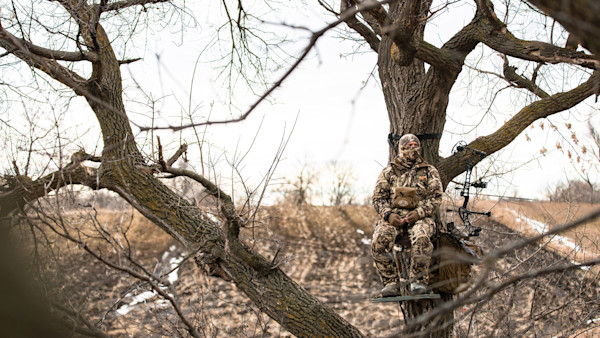
One specific buck occupied my mind going into the 2021 hunting season. I had many trail camera pictures of him and collected both of his sheds from the previous season. When the frigid temperatures and deep snow kept me out of the woods for a while last winter, I spent time on my computer studying maps, logging trail camera data, and whatever else I could do to put together a game plan for this deer. The previous year was the first time I hunted the area, making it more of a learning experience than a well-thought-out tactical plan. I pursue new regions with a three-year plan in mind because I know that history kills big bucks.
Based on previous trail camera knowledge, I knew my target buck liked to use a specific trail in the late season while entering and exiting a brand new logging cut. The trail ran parallel to a small feeder stream in a hemlock-covered valley between two ridge systems. Unfortunately, I didn’t have any camera data from this particular location in the early season, but history has shown that many big woods food sources such as logging cuts are used similarly in the early season and late season.
Wind Mapping The trail camera data showed that the buck primarly used this trail with a particular wind direction, proving him challenging to hunt. So, in late summer, I went into the area on that wind and used milkweed to “wind map” the location. Wind mapping during your boots-on-the-ground scouting is just dropping milkweed puffs in key areas to watch how the wind and thermals interact with each other based on the conditions. I found that if I set up directly over the creek, the thermals of the water would pull my scent downstream, while the wind was consistently blowing the opposite direction just 15 yards in front of the tree on the trail that the buck liked to use. When I find little wind differences like this, I'll mark them for future hunts.
Opening day of the 2021 archery season brought the weather conditions and wind I was looking for. In the morning, I made the long trek to hunt the location with confidence, and an hour after daylight, the buck showed up and gave me a shot at my biggest Pennsylvania archery deer to date. If I hadn’t logged the trail camera information and wind data from the past, I would’ve never hunted a creek bottom in the morning on opening day.
Later in the season, my dad, Joe Martonik, used six years of history about a particular buck to home in and kill that Pennsylvania public-land booner. Some places and deer take more historical knowledge to figure out than others.
Three-Year Plan In addition to hunting specific deer, the history of one particular area can lead to continued success. I’m as guilty as anyone for wanting to find new places. Considering that, you should look at these new areas as an investment in time. The first year is exploratory, meant for testing ideas and assumptions from scouting. The second year allows you to dive a little deeper, utilizing the information that you learned in the previous year to adapt and pivot. From there, you continue to build this catalog of data to become more successful in any given area.
Using historical data to your advantage doesn’t just pertain to hunting a specific deer. Apply this information to a certain area or other areas with similar vegetation and terrain features. For example, some scrapes will light up every year around the same dates or weather conditions. It’s critical to log this data rather than just attempt to remember it. Some people like to write down the data in a hunting notebook, but I tend to go the digital route of writing it in my journal entries within Google Sheets.
Far too often, hunters give up on a particular location and move on before truly understanding it. But Rome wasn’t built in a day and neither are good deer hunting spots. Historical knowledge gives you the confidence to grind out a long season knowing, rather than guessing, you’re in the right spot.
Feature image via Captured Creative.








Conversation